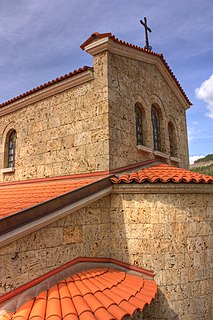
John Carmel Heenan was an English prelate of the Roman Catholic Church. He served as Archbishop of Westminster from 1963 until his death, and was elevated to the cardinalate in 1965.
Hagia Sophia in English usually refers to the Basilica of the Hagia Sophia in Constantinople built in the 6th century.

The Roman Catholic Diocese of Hallam is a diocese of the Latin Church of the Roman Catholic church in England.

The Forty Martyrs of Sebaste or the Holy Forty were a group of Roman soldiers in the Legio XII Fulminata whose martyrdom in 320 for the Christian faith is recounted in traditional martyrologies.

The Holy Forty Martyrs Church is a medieval Eastern Orthodox church constructed in 1230 in the town of Veliko Tarnovo in Bulgaria, the former capital of the Second Bulgarian Empire.
This is a calendar of saints list for the Armenian Apostolic Church.

Saint Elijah Cathedral, is an Eastern Catholic (Maronite) church in Aleppo, Syria, located in the Christian quarter of al-Jdayde. It is named after the biblical prophet Elijah. The church was built in 1873, replacing an old Maronite church. It was renovated in 1914.

Church of the Holy Mother of God, is an Armenian Apostolic church located in the Sulaimaniyeh district of Aleppo, Syria. The church is active since its consecration on May 1 May 1983, by then-Catholicos of the Holy See of Cilicia Karekin II.

The Diocese of Great Britain and Ireland is a diocese of the Russian Orthodox Church Outside Russia (ROCOR), with communities on the territories of the United Kingdom and Ireland. The episcopal seat of the diocese was in Richmond. However, since the departure of Bishop Constantine (Essensky) of Richmond in 1985, the diocese has not had a resident bishop. Since then, the diocese was under the omophor of Archbishop Mark (Arndt) of Berlin, who is also bishop of the ROCOR German diocese, the overseer of the Russian Ecclesiastical Mission in Jerusalem, and First Deputy to the President of the ROCOR Synod of Bishops. He retired as ruling bishop of the Diocese in December 2016. The Diocese was then administered by Bishop Irenei of Sacramento, vicar bishop of the Western American Diocese of the ROCOR. The ruling bishop was Metropolitan Hilarion, First Hierarch of the Russian Church outside of Russia.At its Synod on the 20th September 2018, Bishop Irenei was appointed as Ruling Bishop with the title Bishop of Richmond and Western Europe. He will reside in the UK once arrangements have been made.

Church of the Dormition of Our Lady is a Greek Orthodox church in Jdeydeh quarter of Aleppo, Syria. The church belongs the Greek Orthodox Prelacy, the Diocese of Aleppo. It was built during the first half of the 15th century and is active up to now.

The Diocese of Birobidzhan and Kuldur is a diocese of the Russian Orthodox Church, the centralized religious organization headed by Moscow Patriarchate. The diocese operates churches within the borders of the Jewish Autonomous Region which borders with the Republic of China on the south, Amur Oblast on the west and Khabarovsk Krai on the northeast.

Armenian Diocese of Beroea, is one of the oldest dioceses of the Armenian Apostolic Church outside the historic Armenian territories, covering the Syrian city of Aleppo and the governorates of Deir ez-Zor, Idlib, Latakia and Raqqa. It is known as Beroea, being named after one of the ancient names of Aleppo; when the city was renamed Beroea (Βέροια) in 301 BC by Seleucus Nicator until the Arab conquest of Syria and Aleppo in 637 AD. The seat of the bishop is the Forty Martyrs Cathedral of Aleppo. It is under the jurisdiction of the Holy See of Cilicia of the Armenian Church.

Cathedral of the Holy Martyrs, in Gyumri, Armenia, is the cathedral of the Ordinariate for Armenia, Georgia, Russia, and Eastern Europe of the Armenian Catholic Church. It is located on the Victory Avenue, next to the Dzitoghtsyan Museum of National Architecture. Construction began in December 2010 and was completed in 2015. The cathedral was originally to be named "Holy Cross", but changed to "Holy Martyrs" in honour of the canonized martyrs of the Armenian Genocide.
Church of the Martyrs primarily refers to the group of followers of Meletius of Lycopolis in North Africa in the Fourth Century (C.E.).
This page is based on this
Wikipedia article Text is available under the
CC BY-SA 4.0 license; additional terms may apply.
Images, videos and audio are available under their respective licenses.











